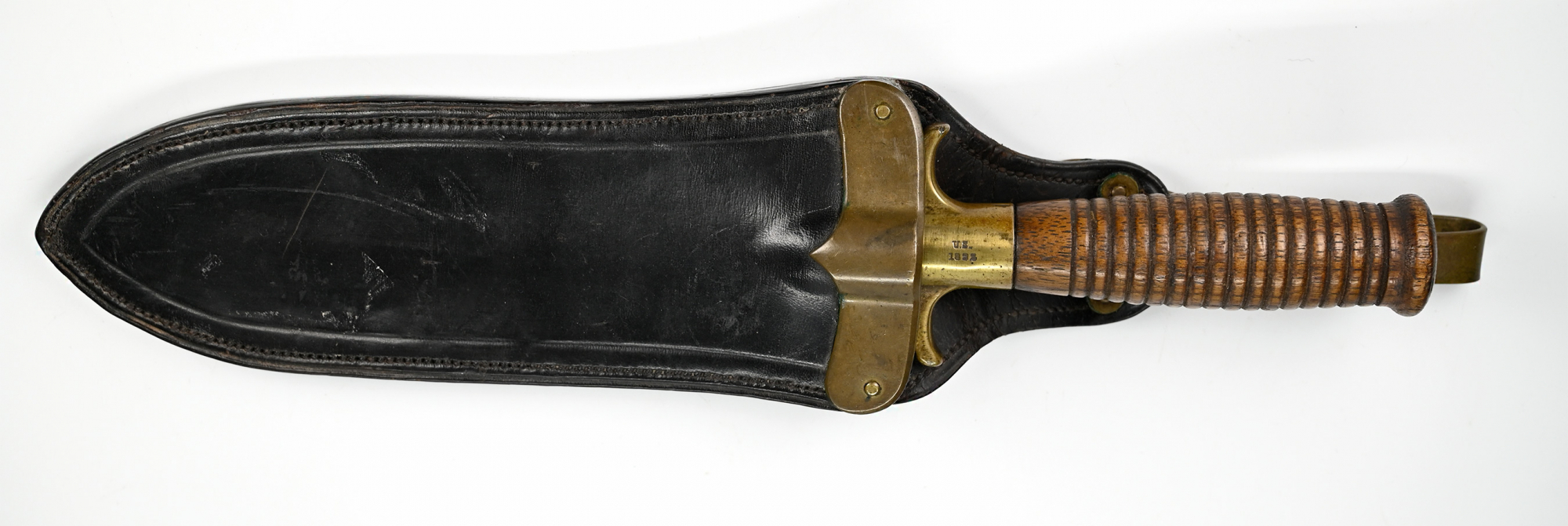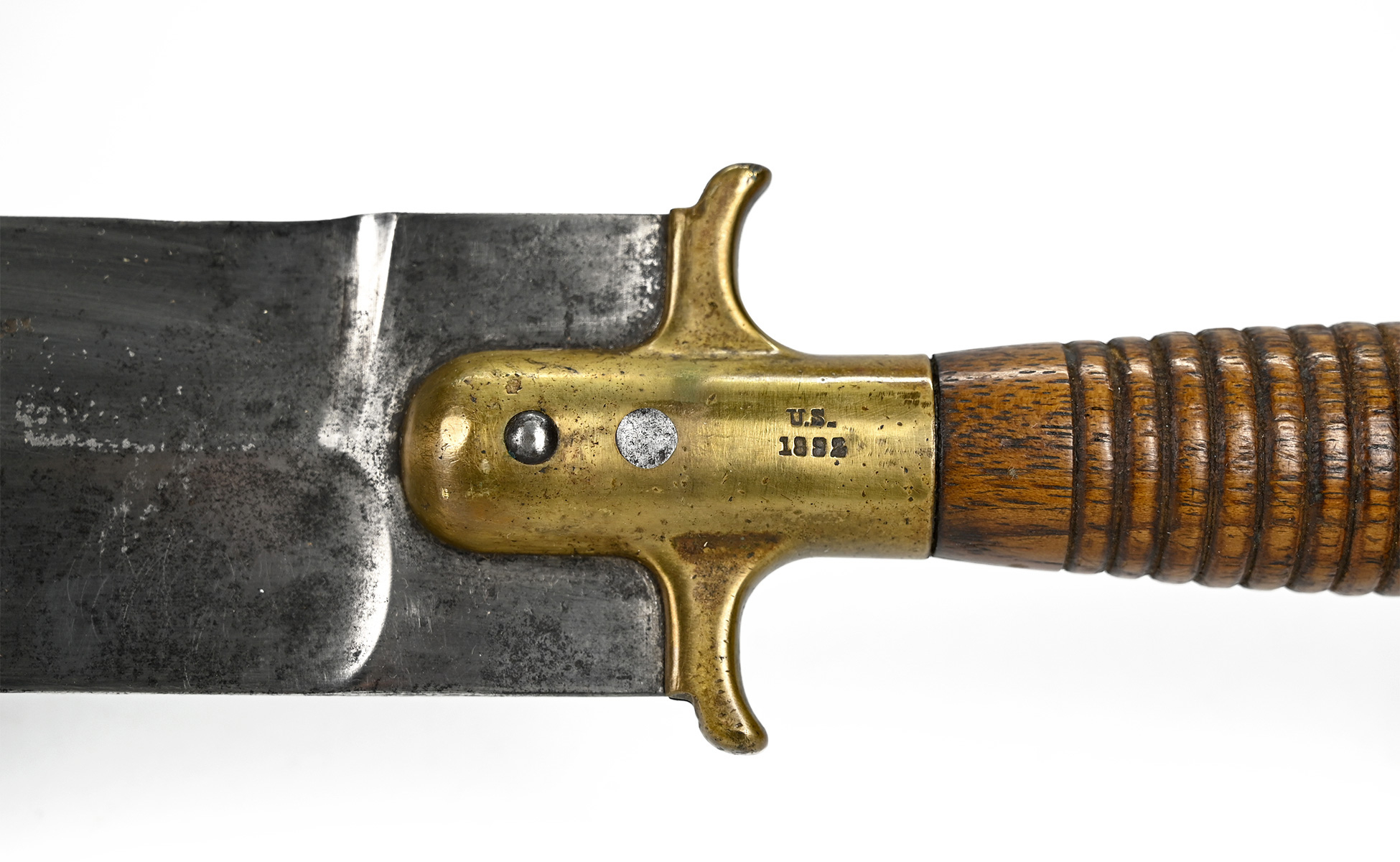site search
online catalog
SCARCE US MODEL 1880 HUNTING KNIFE / MODEL 1892 ENTRENCHING TOOL: ONE OF FIVE HUNDRED

Hover to zoom










$1,195.00
Quantity Available: 1
Item Code: 490-3261
Shipping: Determined by Method & Location of buyer
To Order:
Call 717-334-0347,
Fax 717-334-5016, or E-mail
This is one of just five hundred produced after the redesignation of the M1880 knife as an entrenching tool in 1892 and is carried in the correct fifth type scabbard, introduced in 1890, using a fixed, flat brass belt hook. In overall configuration the knife/entrenching tool did not change much, though the first 1,000 produced in 1881 used a guard with integral handle socket made of iron rather than brass. The knife itself used an 8.5 inch blade, 2 inches wide with spear point and median ridge, and a cylindrical, grooved maple handle with a flat, overhanging pommel. Two production runs of 5,000 knives each beginning in early 1883 utilized a brass guard/handle socket and were serial numbered from 1 to 5,000 in each run. This is a scarce example of the final run of just 500 manufactured after the redesignation of the knife as an entrenching tool, using the same design and brass guard, but making them without serial numbers.
Knife and scabbard are in very good condition. The guard is stamped on one side of the socket, “SPRINGFIELD / ARMORY” and “U.S. / 1892” on the other. The blade edge and point are good. The blade flat shows as semi-bright with some dark gray areas and spotting, some of which is shallow pitting, more on the side with the armory stamp than that with the date. The handle is very good. The pommel cap has some light dings, but there are no chips or cracks.
The scabbard is good, a deep brownish black in color, with the brass retention plate in place on the upper throat and the belt hook on the back. The brass hook shows a clear “R.I.A.” stamp on the reverse and the leather shows a rubbed, but visible “ROCK ISLAND / ARSENAL” stamp, along with what may be a partial inspector stamp or rack number. The scabbard shows some use, with some scuffs, drag lines and pressure dents to the surface and some wrinkling below the hook from flexing, but has good color and is solid. The belt hook was the final design, the first being a spring clamp, the second and third being belt loops with different opening sizes, and the fourth using a similar brass hook with a swivel, which was eliminated in the fifth type as unnecessary.
These were intended to be multi-purpose tools from the beginning. Butchering game and various duties around camp while on campaign were concerns: one veteran praised them since up to that time, “whenever we went out on campaign we had to provide ourselves with hunting or butcher knives at our own expense. (Government bacon being too strong or tough for the ordinary case-knife.)” When not battling government rations, however, they might also be used for entrenching, in the sense of shallow rifle pits or field works, something increasingly stressed in tactics. They were deemed effective enough for that purpose that the trowel bayonet was declared obsolete in late 1881, though it was another ten years before the knife was redesignated as an entrenching tool in 1892.
This is a good example of the scarce final production run that would nicely complete a display of the M1880 hunting knife. [SR] [ph:m]
~~~~~~~~~~~~~~~~~~~~~~~~~~~~~~~~~~~
THIS ITEM, AS WITH ALL OTHER ITEMS AVAILABLE ON OUR WEB SITE,
MAY BE PURCHASED THROUGH OUR LAYAWAY PROGRAM.
CLICK HERE FOR OUR POLICIES AND TERMS.
THANK YOU!
Inquire About SCARCE US MODEL 1880 HUNTING KNIFE / MODEL 1892 ENTRENCHING TOOL: ONE OF FIVE HUNDRED
Most Popular
Historical Firearms Stolen From The National Civil War Museum In Harrisburg, Pa »
Theft From Gravesite Of Gen. John Reynolds »
Selection Of Unframed Prints By Don Troiani »
Fine Condition Brass Infantry Bugle Insignia »
featured item
NEAR EXCELLENT CONDITION COLT M1851 NAVY
A near excellent Middle Fourth Model Colt M1851 Navy, with all-matching serial number 141159, to which the Colt site assigns an 1863 production date. This model falls in the #118000-#16800 range, overlapping with earlier and particularly later… (302-123). Learn More »
site search
Upcoming Events
The shop is currently closed so that we may conduct our annual inventory. We are available by phone… Learn More »


